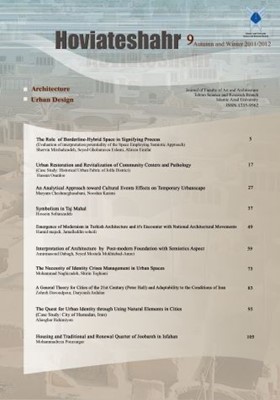Symbolism in Taj Mahal
Subject Areas : architecture
1 - Assistant professor, Azad Islamic University
Keywords:
Abstract :
Taj Mahal is one of the most famous historical shrine from seventieth century that is present and is one of the most important spaces in the world. Due to surveys, it can be said that Taj Mahal is the most symbolic tombs from architectural view and it could be expected that some concepts and symbolic aspects have not surveyed yet enough, because this complex that is in relation with Iranian architecture, haven’t studied by Iranian researchers, and it seems that non Iranian researchers who studied about Taj Mahal, haven’t compare it with Iranian buildings and architectural concepts. Study about Taj Mahal is important and necessary for Iranian experts, because it seems that it have been designed in relation with Iranian architectural patterns. The recognition of some symbolic aspects of this complex, and comparison them with Iranian architecture are the main aims of this research.The questions are these: 1) What concepts and symbols have been considered in the design and construction of Taj Mahal? 2) What are the relations between Taj Mahal design and Iranian architecture? Five hypothesis about the high concepts and symbolism in Taj Mahal and relations between it and Iranian architecture have been presented: 1) Design four areas, is an innovation in application of number four in architectural design. 2) The composition of Hasht Behasht, has drived from the structure of quadripartit plans such as the plan of Chahar Tagh in Apadana. 3) The hierarchy between four areas, is a reflection of kind movement from mundane to heaven. 4) The five parts composition of one dome and four chatri around it, has Iranian origin. 5) The triplex composition of domes in mosque and in house guest, has been Iranian origin too. The research method has been historical interpretational and data was classified in the form of descriptive and analytical and data have been gathered in documentary form and by field study. The theoretical framework has been based on cultural and symbolic view in architecture. On the basis of this observation, cultural and religious phenomena have been used in design of cultural and religious buildings such as tombs and temples. The results of the research shows that there have been many relations between Iranian architecture and the designing of Taj Mahal. Because many of important architectural elements those ware used in design and construction of Taj Mahal such as dome , minar and Iran (balcony) are the elements of Iranian architecture and we can not imagine that many of important Iranian architectural elements and designs ( such as Chahar Tagh , chahar Iran ,chahar sou , chahar bagh , chahar minar and Hasht behsht ) were used accidentalfy. Some of these hypothesis can be considered as a new outlook to the ways of recognition and analysis of religious and ceremonial buildings. Emphasis on visual and symbolic symmetry exemplified by the design and construction of a mosque and guest house with the same plan on the sides of the mausoleum resulting in a view and a spatial composition unseen before.
-آموزگار،ژاله(1387)."تاریخ اساطیری ایران"، چ10، تهران،سمت.
2-استیرلن،هانری،(1381).«دائره المعارف معماری جهان»،ترجمه نادر روز رخ،تهران، فرهنگان.
3- بتلی،کلود، (1389).«گسترش طراحی در معماری هند»، ترجمه حسین سلطان زاده،تهران،چهار طاق.
4-بورکهارت،تیتوس،(1365).«هنر اسلامی»،ترجمه مسعود رجب نیا،تهران،سروش.
5-دورانت،ویل،(1343).«تاریخ تمدن»،ترجمه مهرداد مهرین،کتاب اول، بخش دوم،چ2،تهران،اقبال.
6-راپوپورت،امس،(1366).«منشا فرهنگی مجتمع های زیستی»،ترجمه راضیه رضا زاده،تهران،جهاد دانشگاهی.
7-سلطان زاده،حسین،(1389).«نقش نمادهای هند سی و عددی در آرمانشهر ایرانی»،تهران ،
نامه انجمن جمعیت شناسی ایران.
8------------------ ،(1378).«تداوم طراحی باغ ایرانی در تاج محل »،تهران،دفتر پژوهشهای فرهنگی.
9-سهروردی،شهاب الدین،(1387).«فی حقیقه عشق»،چ3،تهران،مولی.
10-شولتز،کریستیان نوربرگ،(1353)،«هستی،فضا و معماری»،ترجمه محمد حسن حافضی،تهران،کتاب فروشی تهران.
11-غروی،مهدی،(1348).«تاج محل»،ش 81،هنر و مردم.
12-کخ،ابا،(1373).«معماری هند در دوره گورکانیان»،ترجمه حسین سلطان زاده،تهران ،دفتر پژوهشهای فرهنگی.
13-لاهوری،محمد صالح کنبو،(1923).«عمل صالح»،تصحیح غلام یزدانی،ج2،کلکته.
14-ملا عبدالحمید لاهوری،(1867)."پادشاهنامه" تصحیح مولوی کبیرالدین احمد و مولوی عبدالرحیم،2 ج ، کلکته.
15-موریس،جیمز،(1374).«تاریخ شکل شهر»،ترجمه راضیه رضا زاده،تهران،دانشگاه علم و صنعت ایران.
16-ویترو ویوس،(1379).«در تعلیم معمار»،ترجمه ریما فیاض،فصلنامه معماری و فرهنگ،ش4.
17-Chaudhuri,Nirad.C,(1991).’’India’’,in Great Architecture of The World, Edited by John Julius Norwich, Da Capo Press,New York.
18- Dhama, B. L,(1992). ‘’The Taj’’, Sharma, Ajmer.
19-Koch, Ebba,(2001).Mughal Art and Imperial Ideology, Oxford University Press, New Delhi.
20----------------,(2006). The Coplete Taj Mahal, Thames& Hudson, London.
21- Sharma,Y.D,(2001),’’Delhi and its Neighbourhood’’, Archaeological Survey of India , New Delhi
.22-Stierlin, Henri,(1994). Islamic India, Benedikt Taschen, Lausanne.
23- Tilloston,G.H.R,(1990).’’Mughal India’’, Pen
guan Books London.
_||_

